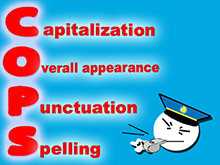How might Ms. Price provide help to meet the individual needs of all her students, including those with disabilities?
Page 5: Material Scaffolding
 Material scaffolding involves the use of written prompts or cues to help the students perform a task or use a strategy. This may take the form of cue sheets or guided examples that list the steps necessary to perform a task. Students can use these as a reference, to reduce confusion and frustration. Ideally, the prompts and cues should be phased out over time as students master the steps of the task or strategy.
Material scaffolding involves the use of written prompts or cues to help the students perform a task or use a strategy. This may take the form of cue sheets or guided examples that list the steps necessary to perform a task. Students can use these as a reference, to reduce confusion and frustration. Ideally, the prompts and cues should be phased out over time as students master the steps of the task or strategy.
guided example
A step-by-step instructional guide for how to apply a strategy or how complete a task
 Ms. Price has created a handout outlining the word-web strategy for her students. They use it to organize their thoughts for their essays about themselves. Now Ms. Price thinks they will be able to use the same handout and strategy to organize their essays about the science fair. Once the students master this step and are able to organize their thoughts without the prompt, Ms. Price plans to phase it out for future writing assignments.
Ms. Price has created a handout outlining the word-web strategy for her students. They use it to organize their thoughts for their essays about themselves. Now Ms. Price thinks they will be able to use the same handout and strategy to organize their essays about the science fair. Once the students master this step and are able to organize their thoughts without the prompt, Ms. Price plans to phase it out for future writing assignments.
During this process, however, Ms. Price discovers that James still needs more support than the rest of the students. When given a blank word-web handout, he is unable to identify the main ideas for his science fair essay. Ms. Price is somewhat surprised that James is having difficulty because he was able to complete the autobiographical essay. After reflecting, Ms. Price realizes that James was able to complete the essay about himself because he used the ideas that she had outlined on the board. Therefore, Ms. Price decides that she needs to provide more support for James by helping him to think through the main ideas of this new essay. She models this process by thinking aloud. This experience reinforces for Ms. Price the importance of checking for students’ understanding during instructional scaffolding.
 In another example of material scaffolding, Mrs. Gardner, the teacher using the COPS strategy, hangs a poster on the wall to display its steps. This poster serves as a prompt for her students as they edit their papers. Once the students have memorized the steps of the strategy, she will remove the poster, but she will continue to prompt them to use the strategy throughout the year.
In another example of material scaffolding, Mrs. Gardner, the teacher using the COPS strategy, hangs a poster on the wall to display its steps. This poster serves as a prompt for her students as they edit their papers. Once the students have memorized the steps of the strategy, she will remove the poster, but she will continue to prompt them to use the strategy throughout the year.